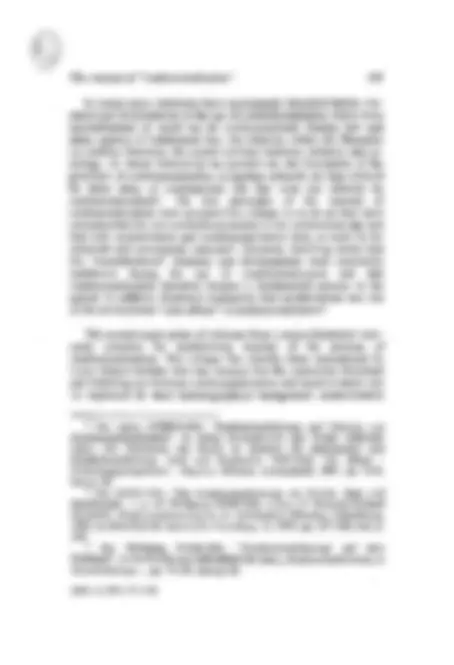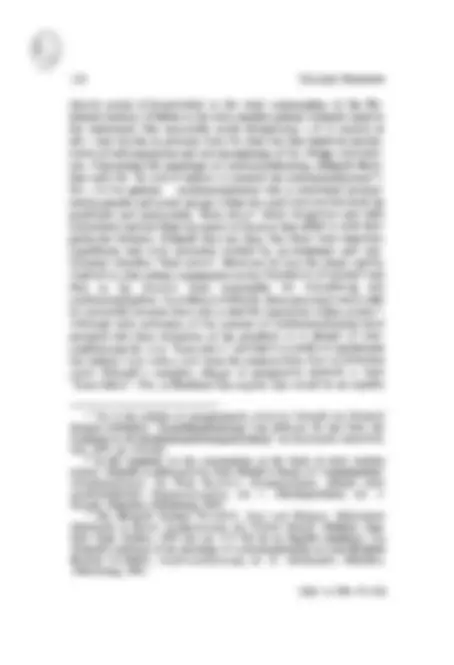
















Study with the several resources on Docsity

Earn points by helping other students or get them with a premium plan


Prepare for your exams
Study with the several resources on Docsity

Earn points to download
Earn points by helping other students or get them with a premium plan
Community
Ask the community for help and clear up your study doubts
Discover the best universities in your country according to Docsity users
Free resources
Download our free guides on studying techniques, anxiety management strategies, and thesis advice from Docsity tutors
An overview of the concept of 'confessionalization' as a historiographical paradigm, developed by Wolfgang Reinhard and Heinz Schilling in the late 1970s and early 1980s. The article discusses the paradigm, its criticisms, and the consequences of confessionalization in early modern Europe. Criticisms include macro-historical perspectives, periodization, the role of 'truth' in confessionalization, and the 'etatistic narrowing' approach.
Typology: Lecture notes
1 / 22

This page cannot be seen from the preview
Don't miss anything!















Humboldt-Universität zu Berlin
Abstract: Since the 1980s the concept of "confessionalization" has been one of the leading interpretive categories in the historiography on early modern Germany. This ar- ticle will, firstly, explain the paradigm of confessionalization as it was developed by Wolfgang Reinhard and Heinz Schilling in the late 1970s and early 1980s. Secondly, it will recapulate the critique that has been voiced against the concept, which can be broadly differentiated into four categories: first, macro-historical criticism; second, the discussion about the periodization of the processes of confessionalization; third, the controversy about the role of theological "truth" in the process of confessionalization and about the specific characteristics of the different confessions; and fourth, the criti- cism of what has been called the "etatistic narrowing" or "top-to-bottom approach" of the concept of confessionalization. In this context, the paradigm of confessionalization has in recent years become a hotly debated subject in the field of tension between mi- cro- and macro-history.
Key words: confessionalization, Reformation, Counter-Reformation, Catholicism, Lutheranism, Calvinism, historiography of confessionalization, micro- and macro-his- tory, societal and cultural history.
El concepto de "confesionalización ": un paradigma historiográfico a debate Resumen: Desde la década de los ochenta el concepto de "confesionalización" ha sido una de las interpretaciones destacadas de la historiografía sobre la Edad Moderna de Alemania. Este articulo explicará, en primer lugar el paradigma de la "confesionali- zación" tal y como fue desarrollado por Wolfgang Reinhard y Heinz Schilling a finales de los setenta y comienzos de los ochenta. En segundo lugar recapitulará las críticas que se han hecho contra el concepto, y que en general, se pueden dividir en cuatro cate- gorías: la primera, la crítica macrohistórica; la segunda, la discusión sobre la periodi- zación de los procesos de confesionalización; tercera la controversia sobre el papel de la "verdad" teológica en el proceso de confesionalización y sobre las características es- pecíficas de las diferentes confesiones; y cuarta la crítica que ha sido denominada la "etatistic narrowing" o "aproximación de abajo-arriba" ("top-to-bottom approach") del concepto de "confesionalización". En este contexto el paradigma de "confesionali- zación" ha llegado a ser en los últimos años objeto de un debate apasionado en el campo de la tensión entre micro- y macro-historia.
Palabras clave: confesionalización, Reforma, Contrarreforma, Catolicismo, Luteranismo, Calvinismo, historiografía de la confesionalización, micro- y macro-histo- ria, historial social y cultural.
[Memoria y Civilización (MyQ, 4, 2001, 93-114]
94 Ute Lotz-Heumann
Since the 1980s the concept of "confessionalization" has been one of the leading interpretive categories in the historiography on early modern Germany. It has shifted historiographical interest from its former emphasis on the early Reformation in the first half of the six- teenth century to the second half of the sixteenth and the early seven- teenth centuries. However, in recent years, this macro-historical para- digm has also met with severe criticism, to which the advocates of confessionalization have answered by defending and also modifying the concept. The following article will, firstly, explain the paradigm of confessionalization as it was developed by Wolfgang Reinhard and Heinz Schilling in the late 1970s and early 1980s. Secondly, it will recapulate the critique that has been voiced against the concept, mainly from within German historiography. This includes very fun- damental criticism, e.g. attacking the paradigm as a "top-to-bottom approach" which has to be overcome by different interpretive models as well as criticism which accepts the usefulness of confessionaliza- tion as a paradigm but suggests certain modifications to the model. The reactions of Wolfgang Reinhard and Heinz Schilling to this cri- tique will also be described. The article will thus try to evaluate the usefulness of the concept of confessionalization as an interpretative category in the field of tension between macro- and micro-history. In this context, it will be instructive to look at the ways in which the paradigm has so far been applied in case studies on the Holy Roman Empire and other European countries.
In German historiography since Leopold von Ranke the sixteenth century was traditionally divided into the "Reformation" of the first half and the "Counter-Reformation" of the second half of the sixteenth century. As the term "Counter-Reformation" has a problematic conno- tation, implying a mere reaction to Protestantism and neglecting that of reform within Catholicism, it was repeatedly criticized. In 1946, Hubert Jedin, a Swiss scholar of Catholic background, therefore suggested the compromise terminology "Catholic reform and Coun-
[AfyC, 4,2001,93-114]
96 Ute Lotz-Heumann
sions and conflicts of the early modern period did not affect only the area of religion and church, but the entire social and political system. "The concept 'confessionalization' contains this political and societal dimension"^4. It proceeds from the general observation that in Old Europe, in the Middle Ages as well as in the early modern period,
(ed.), Bekenntnis und Geschichte. Die Confessio Augustana im historischen Zusammenhang, München, Vögel, 1981, pp. 165-189; Wolfgang REINHARD, "Zwang zur Konfessionalisierung? Prolegomena zu einer Theorie des konfessionellen Zeitalters", in Zeitschrift für historische Forschung, 10, 1983, pp. 257-277; Wolfgang REINHARD, "Reformation, Counter- Reformation, and the Early Modern State. A Reassessment", in Catholic Historical Review, 75, 1989, pp. 383-404; Wolfgang REINHARD, "Was ist katholische Konfessionalisierung?", in Wolfgang REINHARD and Heinz SCHILLING (eds.), Die katholische Konfessionalisierung. Wissenschaftliches Symposion der Gesellschaft zur Herausgabe des Corpus Catholicorum und des Vereins für Reformationsgeschichte, Gütersloh, Gütersloher Verlagshaus, 1995, pp. 419-452; Heinz SCHILLING, "Die Konfessionalisierung im Reich. Religiöser und gesellschaftlicher Wandel in Deutschland zwischen 1555 und 1620", in Historische Zeitschrift, 246, 1988, pp. 1-45, translated into English as: "Confessionalization in the Empire. Religious and Societal Change in Germany between 1555 and 1620", in Heinz SCHILLING, Religion, Political Culture and the Emergence of Early Modern Society. Essays in German and Dutch History, Leiden, New York, Cologne, Brill, 1992, pp. 205-245; Heinz SCHILLING, "Confessional Europe", in Thomas A. BRADY, Jr., Heiko A. OBERMAN and James D. TRACY (eds.), Handbook of European History, 1400-1600. Late Middle Ages, Renaissance and Reformation. II. Visions, Programs and Outcomes, Leiden, New York, Cologne, Brill, 1995, pp. 641- 675; Heinz SCHILLING, "Die Konfessionalisierung von Kirche, Staat und Gesellschaft. Profil, Leistung, Defizite und Perspektiven eines geschichtswissenschaftlichen Paradigmas", in REINHARD and SCHILLING (eds.), Die katholische Konfessionalisierung..., pp. 1-49. See also the proceedings of three major conferences on "confessionalization": Heinz SCHILLING (ed.), Die reformierte Konfessionalisierung in Deutschland - Das Problem der "Zweiten Reformation ". Wissenschaftliches Symposion des Vereins für Reformationsgeschichte 1985, Gütersloh, Gütersloher Verlagshaus, 1986; Hans Christoph RUBLACK (ed.), Die lutherische Konfessionalisierung in Deutschland. Wissenschaftliches Symposion des Vereins für Reformationsgeschichte 1988, Gütersloh, Gütersloher Verlagshaus, 1992; REINHARD and SCHILLING (eds.), Die katholische Konfessionalisierung... (^4) SCHILLING, "Confessionalization in the Empire...", p. 208.
[MyC, 4,2001,93-114]
The concept of "confessionalization "^97
religion and politics, church and state, were closely linked with each other. Thus there was always a connection between confession- building and early modern state formation. These processes could interact in different ways. According to Reinhard and Schilling, in most cases confessionalization "enabled states and societies to inte- grate more t i g h t l y.. I n the Holy Roman Empire, this was the case if the principle of cuius regio, eius religio, established by the Peace of Augsburg in 1555, was successfully enforced by the German princes in their territories. As a consequence, Schilling and Reinhard describe confessionalization as the first phase of early modern absolutism or "social disciplining" (Sozialdisziplinierung)^6. But, as Schilling has always stressed, although this aspect has increasingly been overlooked in subsequent discussions, "confessionalization could also provoke confrontation with religious and political groups fundamentally opposed to this... integration of state and society. The process of con- fessionalization took place between the two poles of state-building and confessional conflict..
In contrast to the older historiography, Reinhard and Schilling are not primarily interested in the differences of doctrine and ritual between the confessions, but approach the subject from a comparative point of view: they look at parallel developments and "functional similarities"^8 between the confessional churches, such as their contri- bution to social control. This has also led to a new terminology. The terms which were used by German historians to describe the develop- ment of the three confessional churches —Catholic reform/Counter- Reformation, Second Reformation (for the introduction of Calvinism in German territories) and Lutheran orthodoxy— have been replaced by the parallel terms Catholic, Calvinist (or Reformed) and Lutheran confessionalization and the term "age of confessionalization" or "con- fessional age". In addition, Reinhard and Schilling emphasize the
(^5) Ibidem, p. 209. (^6) REINHARD, "Zwang zur Konfessionalisierung?...", p. 268. The term Sozialdisziplinierung is originally Gerhard Oestreich's, see Winfried SCHULZE, "Gerhard Oestreichs Begriff 'Sozialdisziplinierung in der Frühen Neuzeit'", in Zeitschrift für historische Forschung, 14, 1987, pp. 265-302. (^7) SCHILLING, "Confessionalization in the Empire...", p. 209. (^8) Ibidem, p. 210.
[MyC.A, 2001,93-114]
The concept of "confessionalization "^99
this way, the confessional churches could be clearly distinguished from one another and possible sources of confusion were eliminated. Second, the distribution and enforcement of these new norms through, for example, confessional oaths and subscription: this enabled church and state to remove dissidents and to ensure the religious orthodoxy of personnel in strategic positions — for instance, theologians, priests, teachers, and secular officials. Third, propaganda and censure: this meant making use of the printing press for propaganda purposes on the one hand and preventing rival churches and religious movements from using the printing press on the other hand. Fourth, internaliza- tion of the new norms through, above all, education, but also through catechizing, sermons, pilgrimages etc. Fifth, disciplining the popula- tion: visitations and the expulsion of confessional minorities were to ensure that the confessional group remained as homogeneous as possi- ble. Sixth, rites and the control of participation in rites: participation in rites like baptism and marriage was ensured through the keeping of registers. Seventh and lastly, Reinhard refers to the confessional regu- lation even of language: for example, while saints' names were par- ticularly appealing to Catholics, they were forbidden in Geneva".
While Reinhard's analysis thus puts more emphasis on what has been labelled the "confessionalization of the churches", Schilling has given more attention to the consequences of confessionalization in state and society1 2. He defines confessionalization as a "fundamental process of society, which had far-reaching effects upon the public and private life of individual European societies"1 3. In consequence, he stresses four factors of political, social, cultural and mental change. First, confessional homogenization, which, in his view, often meant "Christianization" (Delumeau), i.e. the suppression of popular religion in favour of forms of religious practice approved by the confessional
1 1 See REINHARD, "Zwang zur Konfessionalisierung?...", esp. p. 263; REINHARD, "Was ist katholische Konfessionalisierung?...", p. 426; REINHARD, "Reformation, Counter-Reformation, and the Early Modern State...",pp. 391-395. 1 2 B. RÜTH, "Reformation und Konfessionsbildung im städtischen Bereich. Perpektiven der Forschung", in Zeitschrift der Savigny-Stifiung für Rechtsgeschichte, Kanonistische Abt., 77, 1991, pp. 197-282, here pp. 207- 208, note 27. 1 3 SCHILLING, "Confessionalization in the Empire...", p. 209.
[MyQ 4, 2001, 93-114]
100 Ute Lotz-Heumann
churches. Second, social control, i.e. the disciplining of the population in all areas of life and behaviour, which, according to Schilling, re- sulted in the formation of early modern society1 4. Third, the develop- ment of confessional identities which had a decisive influence on the formation of cultural and political —often national— identities1 5. And fourth, the "gains" for the state resulting from the process of confessionalization: while Protestant princes gained full control over their churches by becoming their spiritual heads, far-reaching control over the church was in practice also achieved in Catholic states. This entailed an extension of state bureaucracy and thus an intensification of the process of state formation1 6.
1 4 See Heinz SCHILLING, "Die Kirchenzucht im frühneuzeitlichen Europa in interkonfessionell vergleichender und interdisziplinärer Perspektive - eine Zwischenbilanz", in Heinz SCHILLING (ed.), Kirchenzucht und Sozialdisziplinierung im frühneuzeitlichen Europa, Berlin, Duncker & Humblot, 1994, pp. 11-40; Heinz SCHILLING, "Profil und Perspektiven einer interdisziplinären und komparatistischen Disziplinierungsforschung jenseits einer Dichotomie von Gesellschafts- und Kulturgeschichte" (with English summary), in Heinz SCHILLING (ed.), Institutionen, Instrumente und Akteure sozialer Kontrolle und Disziplinierung im frühneuzeitlichen Europa / Institutions, Instruments and Agents of Social Control and Discipline in Early Modern Europe, Frankfurt a.M., Klostermann, 1999, pp. 3-36. 1 5 See Heinz SCHILLING, "Nationale Identität und Konfession in der europäischen Neuzeit", in Bernhard GIESEN (ed.), Nationale und kulturelle Identität. Studien zur Entwicklung des kollektiven Bewußtseins in der Neuzeit, Frankfurt a.M., Suhrkamp, 1991, pp. 192-252; Heinz SCHILLING, "Konfessionelle und politische Identität im frühneuzeitlichen Europa", in Antoni CZACHAROWSKI (ed.), Nationale und ethnische Minderheiten und regionale Identitäten in Mittelalter und Neuzeit, Toruri, Wydawnictwo Uniwersytetu Mikolaja Kopernika, 1994, pp. 103-123; Heinz SCHILLING, "Confessionalisation and the Rise of Religious and Cultural Frontiers in Early Modern Europe", in Eszter ANDOR and Istvän György TÖTH (eds.), Frontiers of Faith. Religious Exchange and the Constitution of Religious Identities, 1400-1750, Budapest, Central European University/European Science Foundation, 2001, pp. 21-35. 1 6 See Heinz SCHILLING, "Nation und Konfession in der frühneuzeitlichen Geschichte Europas. Zu den konfessionsgeschichtlichen Voraussetzungen der frühmodernen Staatsbildung", in Klaus GARBER (ed.), Nation und Literatur im Europa der Frühen Neuzeit, Tübingen, Niemeyer, 1989, pp. 87-107.
[MyC, 4,2001,93-114]
102 Ute Lotz-Heumann
confessionalization, the "apogee of confessionalization''2 3 from the 1580s to the 1620s. During this phase several German princes intro- duced the "Second Reformation", i.e. Calvinism, in their territories. At the same time, the concord movement was vibrant in Lutheran Germany and in Catholic territories Tridentine Reformation had be- come a major force. All this took place against a political background which was more and more characterized by confrontation on all levels of Imperial politics —notably in the Imperial diet and the Imperial chamber court (Reichskammergericht). One of the more striking examples of how confessionalization affected the whole of society and everyday life is the calendar dispute. After Pope Gregory had introduced a much-needed calendar reform in 1582, Protestants did not accept this new calendar because it came from the pope. In conse- quence, even the time became confessionalized with the Protestants living ten days behind the Catholics until 1699/17002 4. The fourth and last phase marks "the end of confessionalization under the conditions of war and on the basis of the Peace of Westphalia"2 5. It began in the 1620s, during the Thirty Years' War, when it became clear that the brutality of confessional conflict could lead to complete destruction, and lasted until the early eighteenth century. It was characterized by the rise of irenicism and new religious movements such as Pietism.
The paradigm of confessionalization itself as well as the dis- cussions following from it have resulted in a shift of emphasis in his- toriographical research in Germany. While in the early 1980s, Win- fried Schulze could still write that "any interest in this period [between the Peace of Augsburg and the Thirty Years' War] can scarcely arise from the period itself'2 6 , numerous Ph.D. theses and
(^23) Ibidem, p. 226. 2 4 See SCHILLING, Aufbruch und Krise..., pp. 264-266. 2 5 SCHILLING, "Confessionalization in the Empire...", p. 230. 2 6 The original quote is in Winfried SCHULZE, "Möglichkeiten der Reichspolitik zwischen Augsburger Religionsfrieden und Ausbruch des 30jährigen Krieges. Einleitung", in Zeitschrift für historische Forschung, 10,
[MyC, 4,2001,93-114]
The concept of "confessionalization " 103
other works have since been written on this period2 7. As a conse- quence, the concept of confessionalization has been proven to be a fruitful research instrument, but has also been criticized in various ways. The critique of the paradigm of confessionalization can be broadly differentiated into four categories: first, macro-historical criti- cism; second, the discussion about the periodization of the processes of confessionalization; third, the controversy about the role of theo-
1983, pp. 253-256, here p. 253; for the translation see SCHILLING, "Confessionalization in the Empire...", p. 205. 2 7 See, for example, Thomas Paul BECKER, Konfessionalisierung in Kurköln. Untersuchungen zur Durschsetzung der katholischen Reform in den Dekanaten Ahrgau und Bonn anhand von Visitationsprotokollen 1583-1761, Bonn, Röhrscheid, 1989; Arno HERZIG, Reformatorische Bewegungen und Konfessionalisierung. Die habsburgische Rekatholisierungspolitik in der Grafschaft Glatz, Hamburg, Dölling und Galitz, 1996; R. Po-chia HSIA, Social Discipline in the Reformation. Central Europe 1550-1750, London, New York, Routledge, 1989 (with a somewhat misleading title); Ute LOTZ- HEUMANN, Die doppelte Konfessionalisierung in Irland. Konflikt und Koexistenz im 16. und in der ersten Hälfte des 17. Jahrhunderts, Tübingen, Mohr Siebeck, 2000; Michael G. MÜLLER, Zweite Reformation und ständische Autonomie im königlichen Preußen. Danzig, Elbing und Thorn während der Konfessionalisierung 1557 bis 1660, Berlin, Akademie-Verlag, 1997; Siegrid WESTPHAL, Frau und lutherische Konfessionalisierung. Eine Untersuchung zum Fürstentum Pfalz-Neuburg 1542-1614, Frankfurt a.M., Lang, 1994. See also the following collections of essays: Joachim BAHLCKE and Arno STROHMEYER (eds.), Konfessionalisierung in Ostmitteleuropa. Wirkungen des religiösen Wandels im 16. und 17. Jahrhundert in Staat, Gesellschaft und Kultur, Stuttgart, Steiner, 1999; Burkhard DIETZ and Stefan EHRENPREIS (eds.), Drei Konfessionen in einer Region. Beiträge zur Geschichte der Konfessionalisierung im Herzogtum Berg vom 16. bis zum 18. Jahrhundert, Köln, Rheinland-Verlag, 1999; Peer FRIEß and Rolf KIEßLING (eds.), Konfessionalisierung und Region, Konstanz, Universitätsverlag Konstanz, 1999. For a review essay see Heinz SCHILLING, "Literaturbericht 'Konfessionsbildung' und 'Konfessionalisierung'", in Geschichte in Wissenschaft und Unterricht, 41, 1991, pp. 447-463, "Literaturbericht 'Konfessionelles Zeitalter'", in Geschichte in Wissenschaft und Unterricht, 48, 1997, pp. 350-369 (part I), pp. 618-627 (part U), pp. 682-694 (part III), pp. 748-766 (part IV), to be continued; for a review article that takes the story up to the nineteenth century see Joel F. HARRINGTON and Helmut Walser SMITH, "Confessionalization, Community, and State Building in Germany, 1555-1870", in Journal of Modern History, 69, 1997, pp. 77-101.
[MyC,4, 2001,93-114]
The concept of "confessionalization " 105
In recent years, historians have increasingly identified further ele- ments and developments in the age of confessionalization which were unconfessional or could not be confessionalized: Roman law and many aspects of matrimonial law, the relations within the Humanist res publica litteraria; the mystic-spiritual tradition; alchemy and as- trology. As Anton Schindling has pointed out, the boundaries of the paradigm of confessionalization in modern research are thus defined by those areas of contemporary life that were not affected by confessionalization3 0. The two advocates of the concept of confessionalization have accepted this critique in so far as they have conceded that the non-confessional existed in the confessional age and that both secularization and confessionalization were at work in the sixteenth and seventeenth centuries3 1. However, Schilling insists that the "unconfessional" elements and developments were essentially ineffective during the age of confessionalization and that confessionalization therefore remains a fundamental process of the period. In addition, Reinhard emphasizes that secularization was one of the unintentional "side-effects" of confessionalization3 2.
The second major point of criticism from a macro-historical view- point concerns the modernizing impetus of the process of confessionalization. This critique has recently been summarized by Luise Schorn-Schiitte who has stressed that the connection Reinhard and Schilling see between confessionalization and modernization can be explained by their historiographical background: modernization
3 0 See Anton SCHINDLING, "Konfessionalisierung und Grenzen von Konfessionalisierbarkeit", in Anton SCHINDLING and Walter ZIEGLER (eds.), Die Territorien des Reichs im Zeitalter der Reformation und Konfessionalisierung. Land und Konfession 1500-1650. VII: Bilanz - Forschungsperspektiven - Register, Münster, Aschendorff, 1997, pp. 9-44, here p. 40. 3 1 See SCHILLING, "Die Konfessionalisierung von Kirche, Staat und Gesellschaft...", p. 22; Wolfgang REINHARD, review of: Heinrich Richard SCHMIDT, Konfessionalisierung im 16. Jahrhundert, München, Oldenbourg, 1992, in Zeitschrift für historische Forschung, 22, 1995, pp. 267-269, here p. 269. 3 2 See Wolfgang REINHARD, "'Konfessionalisierung' auf dem Prüfstand", in BAHLCKE and STROHMEYER (eds.), Konfessionalisierung in Ostmitteleuropa..., pp. 79-103, here p. 80.
[AfyC, 4,2001,93-114]
106 Ute Lotz-Heumann
was an important concept for the historiography of the 1970s which proceeded from the assumption that there was a teleological process of social change, constantly moving toward improved social and po- litical structures. As this notion of modernization has by now been revised and replaced by the notion of different potentials and aims of development coexisting simultaneously in history, this aspect of the concept of confessionalization can, according to Schorn-Schutte, not be maintained3 3. In reply, Wolfgang Reinhard has insisted on the neu- tral —not positive— meaning of the term "modernization", citing the "modernity" of the Third Reich as an example. And he has made clear that in his opinion the modernizing impulses of confessionalization were unintentional: e.g. contemporaries saw the enforcement of rites as a measure to ensure a confessionally unified population, but this contributed to the processes of rationalization and social disciplining3 4.
Second, the discussion about the periodization of the process of confessionalization is already inherent in the differences in definition between Reinhard and Schilling. As we have seen above, Schilling's periodization identifies an age of confessionalization between the 1570s and the beginning of the Thirty Years' War. Although he has not developed a detailed periodization of the confessionalization process, Reinhard has extended the confessionalization process much further. On the one hand, he sees the beginning of the age of confessionalization in the 1520s with the development of written confessions and the Confessio Augustana of 1530 as a first climax of this process. On the other hand, he describes the process as ending only in the early eighteenth century, around the time of the expulsion of the Salzburg Protestants in 1731-323 5. However, Reinhard also de- fines the processes of confessionalization in the three major con-
3 3 See Luise SCHORN-SCHUTTE, "Konfessionalisierung als wissenschaftliches Paradigma?", in BAHLCKE and STROHMEYER (eds.), Konfessionalisierung in Ostmitteleuropa..., pp. 61-77, here pp. 66-68. 3 4 See Wolfgang REINHARD, "Gegenreformation als Modernisierung? Prolegomena zu einer Theorie des konfessionellen Zeitalters", in Archiv für Reformationsgeschichte, 68, 1977, pp. 226-252, here p. 230; W. REINHARD, "Was ist katholische Konfessionalisierung?...", p. 422; REINHARD, "'Konfessionalisierung' auf dem Prüfstand...", pp. 85-86. 3 5 See REINHARD, "Konfession und Konfessionalisierung in Europa...", p. 188; REINHARD, "Was ist katholische Konfessionalisierung?...", p. 436.
[AfyC, 4,2001,93-114]
108 Ute Lotz-Heumann
church and therefore has to be seen as a decisive turning point. He draws the conclusion that Reformation and confessionalization cannot be differentiated as clearly as in Schilling's periodization of the process of confessionalization. Rather, both processes were, according to Kaufmann, closely intertwined3 9.
Third, both Ziegler, as we already have seen, and Kaufmann se- verely criticize the concept of confessionalization for ignoring the question of theological truth. Kaufmann regards the treatment of re- ligion in the context of the paradigm of confessionalization as "functional-reductionist"4 0 —functional because the concept only looks at the function of religion in society and reductionist because in this way the characteristics of the early modern confessional churches are levelled4 1. This aspect has in fact been criticized in the discussions on confessionalization from the very beginning. Already during the first symposium on Calvinist confessionalization in the Empire4 2 , par- ticipants drew attention to the fact that the propria of the Calvinist (Reformed) church in Germany were not sufficiently considered in the framework of confessionalization. Recently, Anton Schindling has again demanded to give more consideration to the specific character of each of the early modern confessional churches, which in theology, piety and spirituality were radically different from one another4 3. The two advocates of the concept of confessionalization have reacted in opposite ways to this kind of critique. Heinz Schilling accepts that these objections bring to light "weak spots" of the paradigm and suggests to overcome the weaknesses by integrating into the concept
3 9 See Thomas KAUFMANN, "Die Konfessionalisierung von Kirche und
Gesellschaft. Sammelbericht über eine Forschungsdebatte", in Theologische Literaturzeitung, 121, 1996, cols. 1008-1025 (part 1), cols. 1112-1121 (part 2), here cols. 1118, 1115. 4 0 "...funktionalistisch-reduktionistische Betrachtung der Religion...",
ibid., col. 1121. 4 1 See ibidem., cols. 1115-1116, 1121; ZIEGLER, "Typen der
Konfessionalisierung...", p. 417; ZIEGLER, "Kritisches zur Konfessionalisierungsthese...". 4 2 See SCHILLING (ed.), Die reformierte Konfessionalisierung in
Deutschland... 4 3 See SCHINDLING, "Konfessionalisierung und Grenzen von
Konfessionalisierbarkeit...", p. 12.
[MyC, 4,2001,93-114]
The concept of "confessionalization " 109
of confessionalization perspectives stressing the differences between the confessional churches4 4. In contrast, Wolfgang Reinhard has stressed that the paradigm confessionalization consciously ignores confessional propria as part of its methodological approach. There- fore, he sees no need for an integration of this perspective, but argues for its continued exclusion from the paradigm of confessionalization in terms of a scholarly "division of labour"4 5.
The fourth point of critique on the paradigm of confessionalization is probably the most important one because it impinges on the general discussion about the relationship between macro- and micro-history. The question of the relation between history "from above" and "from below", between societal history (Gesellschaftsgeschichte) and cul- tural history (Kulturgeschichte) has in recent years found expression in a very lively debate in German historiography4 6. Especially younger historians who are influenced by the new cultural history and histo- rians working on other regions of Europe than the Holy Roman Em- pire have identified several "blind spots" of the concept. Above all, they have expressed severe doubts concerning the close association between confessionalization and state-building postulated by Reinhard and Schilling. As we have seen above, the advocates of the concept of confessionalization proceed from the assumption that confessionali- zation was decisively influenced or even set in motion by the early modern state and that it was therefore a top-to-bottom process: the people thus appear as subjects which state and church disciplined.
From a micro-historical point of view and also from the point of view of research into processes of social disciplining in the early modern period, Heinrich Richard Schmidt has thus criticised the eta- tistic focus and the overestimation of the role of the state in the para- digm of confessionalization. Drawing on the results of his research on
4 4 See SCHILLING, "Die Konfessionalisierung von Kirche, Staat und Gesellschaft...", pp. 16-21. 4 5 See REINHARD, "Was ist katholische Konfessionalisierung?...", p.
435. 4 6 See e.g. Wolfgang HARDTWIG and Hans Ulrich WEHLER (eds.),
Kulturgeschichte heute, Göttingen, Vandenhoeck & Ruprecht, 1996; Thomas MERGEL and Thomas WELSKOPP (eds.), Geschichte zwischen Kultur und Gesellschaft. Beiträge zur Theoriedebatte, München, Beck, 1997.
[MyC, 4,2001,93-114]
The concept of "confessionalization "^111
one-sided view, "which plays down religious and administrative his- tory in favour of a social history understood as the history of the lower orders"5 0.
Proceeding from other perspectives and other case studies, several historians besides Schmidt have in recent years criticized the concept of confessionalization for its emphasis on the initiatives of state and church. In this context, territories of mixed confessional make-up within and outside of the Holy Roman Empire have proven to be suitable "test cases" for the critique of the paradigm of confessionali- zation, in particular the connection between state formation, social disciplining and confessionalization and the problem of "success" or "failure" of confessionalization "from above". For the Holy Roman Empire, Marc Forster has drawn attention to the bishopric of Speyer, where the Catholic communities developed a Catholic identity "from below" without being influenced either by Tridentine reform or by confessionalization measures by the state. Such measures where in fact almost completely absent from the bishopric. Forster draws the conclusion that the concept of confessionalization cannot be applied to this territory because "the Catholic population of the Bishopric of Speyer developed a confessional culture without being con- fessionalized"5 1. In a collection of essays on the duchy of Berg, a multi-confessional region in north-western Germany, the concept of confessionalization as a successful "top-to-bottom process" is also called into question. Because of the coexistence of Catholicism, Lu- theranism and Calvinism in the region, the "etatistic" version of the paradigm of confessionalization can clearly not be applied to this case. However, the editors of the volume, Stefan Ehrenpreis und Burkhard
5 0 "...die Religionsgeschichte wie die Institutionengeschichte zugunsten einer als Unterschichtengeschichte verstandenen Sozialgeschichte herunterzuspielen...", REINHARD, review of: SCHMIDT, Konfessionalisierungim 16. Jahrhundert..., p. 269. 5 1 Marc R. FORSTER, The Counter-Reformation in the Villages. Religion and Reform in the Bishopric of Speyer, 1560-1720, Ithaca, London, Cornell University Press, 1992, p. 4. However, in his latest book Forster actually uses the term "confessionalization" in a chapter heading: see Marc R. FORSTER, Catholic Revival in the Age of the Baroque. Religious Identity in Southwest Germany, 1550-1750, Cambridge, Cambridge University Press, 2001, pp. 21- 36: "Confessionalization under Austrian leadership".
[MyC, 4,2001,93-114]
112 Ute Lotz-Heumann
Dietz, have interpreted the formation processes on the local level, which resulted in many conflicts between the different confessional communities, as competing processes of confessionalization "from below"5 2.
Comparable suggestions have been put forward by historians working on European countries other than the Holy Roman Empire. Olaf Morke has made clear that the concept of confessionalization cannot be applied to the Dutch Republic as a whole because of its multi-confessionalism and —in early modern European terms— far- reaching toleration5 3. However, Morke drew attention to the fact that in the Netherlands it was the individual religious communities which experienced processes of confessionalization. Therefore, Morke iden- tifies not one confessionalization, but many different confessionaliza- tions within one political and territorial unity. Thus, the Netherlands do not, according to Morke, fit the "etatistic mainstream" of the para- digm of confessionalization, which does, however, not mean that pro- cesses of confessionalization did not take place there5 4. Similar results have been presented by scholars working on east central Europe, no- tably by Winfried Eberhard. He has shown that in the countries of east central Europe, above all in Bohemia, the German model of "con- fessionalization from above" can also not be applied. Similar to the Netherlands, confessionalization processes took place within a multi- confessional framework and were thus regionalized and localized. And, in contrast to Germany, they were not initiated by the state
5 2 See Stefan EHRENPREIS, "Konfessionalisierung von unten. Konzeption und Thematik eines bergischen Modells?", in DIETZ and EHRENPREIS (eds.), Drei Konfessionen in einer Region..., pp. 3-13, herepp. 8-9. (^5) See Olaf MÖRKE, "'Konfessionalisierung' als politisch-soziales Strulcturprinzip? Das Verhältnis von Religion und Staatsbildung in der Republik der Vereinigten Niederlande im 16. und 17. Jahrhundert", in Tijdschrift voor Sociale Geschiedenis, 16, 1990, pp. 31-60. 5 4 See Olaf MÖRKE, "Die politische Bedeutung des Konfessionellen im Deutschen Reich und in der Republik der Vereinigten Niederlande. Oder: War die Konfessionalisierung ein 'Fundamentalvorgang'?", in Ronald G. ASCH and Heinz DUCHHARDT (eds.), Der Absolutismus - ein Mythos? Strukturwandel monarchischer Herrschaft in West- und Mitteleuropa (ca. 1550-1700), Köln, Weimar, Wien, Böhlau, 1996, pp. 125-164, esp. pp. 145- 146 and 155.
[MyC, 4,2001,93-114]